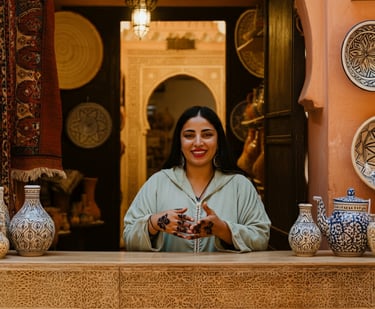Moroccan Souks: Pottery as a Cultural and Economic Treasure
CULTURE & HERITAGE
Moroccan souks are lively markets characterized by brilliant colors, noises, and bustle, functioning as cultural centers where craftsmen and merchants converge to exhibit their talents and wares. Pottery stands out among the several traditional crafts shown, embodying the rich history of Moroccan workmanship and serving a vital function in the everyday lives of its populace. The souks give tourists an insight into Morocco's creative heritage while simultaneously maintaining the cultural and economic importance of ceramics.
A Custom Rich in Historical Significance
Moroccan pottery transcends mere functionality; it is a longstanding tradition intricately woven into the nation’s history and culture. Pottery creation, an art form down through generations, exemplifies the expertise of Moroccan potters who have refined their craft over several years. The methods and designs used in contemporary Moroccan pottery culminate millennia of refinement, influenced by the nation's varied heritage, including Berber, Arab, and Andalusian traditions.
Historically, pottery has been integral to daily life in Morocco. In antiquity, pottery was created to meet fundamental requirements for cooking, storage, and transportation. Over time, the practicality of pottery integrated with aesthetics, resulting in the complicated and artistically made pieces seen today. The craftsmen in Moroccan souks use traditional methods, using natural clay obtained from areas such as Safi and Fez, known for their ceramic heritage. The clay is manually molded or formed on a wheel, glazed, and often adorned with unique geometric designs, floral patterns, or calligraphy.
A prominent characteristic of Moroccan ceramics is its association with the Islamic artistic legacy. Due to Islam's prohibition on the representation of human or animal forms in art, Moroccan potters have refined abstract designs, using repeated geometric patterns, elaborate arabesques, and delicate floral motifs. These decorations are not only ornamental; they also function to commemorate spiritual and cultural values. Every pot, plate, and jar embodies the heritage of a skill that has been sustained and valued over generations, making Moroccan pottery not only a functional item but an artistic creation imbued with profound cultural importance.
Cultural and Practical Importance
Moroccan pottery is distinctive since it integrates artistic expression with functional usefulness, embodying cultural significance and practical application. The quintessential illustration of this is the tagine, a conical earthenware vessel used for the slow-cooking of Morocco’s hallmark cuisines. The tagine serves a functional role in the kitchen, used for crafting savory stews by retaining steam and intensifying tastes. These clay jars are beautifully adorned, rendering them aesthetically pleasing artifacts that exemplify the artisan's craftsmanship and the nation's culinary heritage.
Besides tagines, Moroccan pottery encompasses a diverse array of products that fulfill both aesthetic and utilitarian purposes. Souks often include decorative plates, bowls, and cups, some embellished with traditional themes and others showcasing modern designs. Numerous items are crafted for quotidian utilization, including drinking containers, cooking pots, and storage jars. Notwithstanding their practical use, these things are often elaborately adorned, reflecting the Moroccan conviction that quotidian objects need to be both aesthetically pleasing and utilitarian.
In Moroccan families, pottery is crucial to everyday living, representing the nation's profound link to its history while being a vital aspect of contemporary existence. Moroccan pottery is used in meal preparation, food serving, and entertaining visitors to unite individuals, cultivate community, and honor cultural history. The use of pottery in various situations aids in upholding the nation's traditions, so retaining a feeling of continuity and collective history.
Economic Consequences
In addition to its cultural importance, pottery has a substantial economic influence in Morocco, especially inside the vibrant souks where it is marketed. The manufacture and commerce of pottery serve as a vital source of revenue for several Moroccan artists and their families. Souks serve as primary markets for these items, enabling artists to sell their works directly to customers, thus circumventing middlemen who may otherwise appropriate a portion of their revenues. This direct-to-consumer strategy guarantees that the economic advantages of the craft remain within local communities, offering a sustainable living for several individuals.
The pottery sector has always played a vital role in Morocco's economy. In areas like as Safi and Fez, renowned for their pottery traditions, whole communities participate in the pottery manufacturing process, including clay extraction and preparation, shaping, decorating, and marketing the final goods. Artisans in these areas depend on their art not just for financial sustenance but also for the preservation of their cultural legacy. Tourists significantly influence the pottery market, since visitors to Morocco are often attracted to the beauty and authenticity of these handcrafted items.
The ceramic trade not only supports individual craftspeople but also enhances the broader economy by generating visitors and promoting Moroccan culture internationally. The growing interest in Moroccan crafts, especially ceramics, is elevating demand for these products, resulting in enhanced economic prospects for industry participants. Thus, pottery acts as a conduit between tradition and modernity, contributing to the preservation of Morocco’s cultural and economic framework.
A Center for Cultural Exchange
Moroccan souks serve as both commercial hubs and dynamic venues for cultural interaction. These markets draw people globally, keen to engage with the profound history and craftsmanship of Morocco. Pottery, therefore, is a fundamental aspect of this experience, attracting travelers with its vivid hues, elaborate patterns, and historical importance.
For many tourists, acquiring a piece of Moroccan pottery transcends mere souvenir shopping; it serves as a means of engaging with the nation's cultural history. Purchasing pottery at the souk enables travelers to interact with local craftspeople, acquire knowledge of traditional methods, and get a tangible artifact of Moroccan culture. This interchange advantages craftsmen and tourists, enhancing worldwide awareness and admiration of Moroccan handicrafts.
Furthermore, the global exposure of Moroccan ceramics facilitates the promotion of this art form beyond national boundaries. The increasing global recognition and appreciation of Moroccan pottery creates new markets for craftsmen and enhances Morocco's status as a hub of traditional craftsmanship.
Challenges and Resilience
Notwithstanding its cultural and commercial significance, Moroccan pottery encounters several problems in the contemporary worldwide market. The proliferation of mass-produced items, especially those fabricated from less expensive materials, has engendered competition for conventional artists. A growing number of customers, especially in metropolitan regions, are choosing factory-produced alternatives that are more affordable and easily accessible.
Nevertheless, Moroccan artists have shown tenacity notwithstanding these hardships. Numerous individuals have modified their methods and designs to cater to contemporary preferences while preserving the authenticity of their artistry. Initiatives to advocate for sustainable practices, including using locally sourced materials and eco-friendly manufacturing techniques, are contributing to the continued relevance of traditional pottery in the contemporary market.
Organizations and governmental programs focused on the preservation of traditional crafts have contributed to the support of Moroccan pottery. These initiatives include the promotion of artisan cooperatives, the provision of training programs for emerging potters, and the enhancement of knowledge about the cultural and economic importance of handcrafted products. These endeavors safeguard the traditions of Moroccan ceramics, ensuring the craft's sustainability amid globalization and changing customer demands.
Summary
Pottery has a significant position in Moroccan souks, symbolizing the nation's rich cultural past and functioning as an essential component of everyday life. It represents a longstanding legacy of craftsmanship, creativity, and utility while enhancing the economic welfare of artists and their families. The lively souks of Morocco persist in drawing global tourists, with ceramics serving as a lasting emblem of the nation's cultural heritage, connecting art and daily existence while highlighting the perseverance and ingenuity of Moroccan artists.


